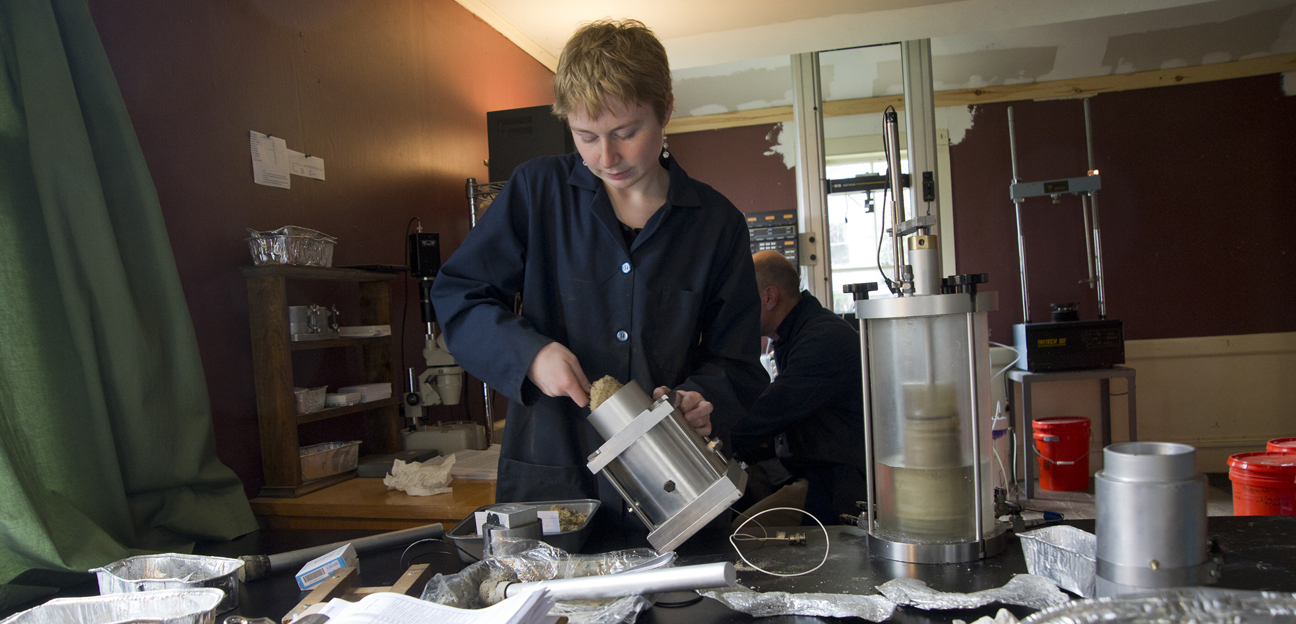
The Race is on to Ensure Horse Track Safety
The antique Cape Cod-style house on a quiet corner in Orono, Maine, belies its latest occupant. Computers, laboratory benches, and hefty equipment and machinery dominate the furnishings. Lining the walls are stacks of plastic buckets containing labeled soil samples from horse racing tracks all across the U.S. and Canada.
While the Racing Surfaces Testing Laboratory may keep an outwardly low profile, the horse racing world is beating at path to its door, hoping to tap into research to improve what have been increasingly long odds in recent decades against keeping equines and their jockeys safe.
Racing Surfaces Testing Laboratory founder Michael “Mick” Peterson, a professor of mechanical engineering at the University of Maine, has been contracting with track owners and racing industry leaders since 2004 to test the strength, stability and water-retaining qualities of track surfaces, both natural and synthetic. Groups tapping into the research include Churchill Downs Inc., which launched a Safety from Start to Finish program three years ago and has had Peterson evaluating its racing surfaces.
Interest in Peterson’s work has surged in response to recent high-profile racing injuries that have captured public attention. In 2008, the 3-year-old filly Eight Belles was euthanized on the track after breaking both front ankles immediately following a second-place finish in the Kentucky Derby. In 2006, the colt Barbaro, a favorite for that year’s Triple Crown, shattered 20 bones in his right hind leg while running the Preakness. Barbaro was put down eight months later after efforts to rehabilitate him failed.
Devastating injuries such as these raise important questions about track conditions and other factors, says the director of the laboratory, UMaine engineering graduate student Christie Mahaffey.
“If a track can say ‘We’ve done all this testing and we have the numbers to back up the integrity of our track,’ then it forces officials to look at other issues like drug use, training and genetics,” she says.
Mahaffey is examining the interface between a horse’s galloping hoof and the track surface it strikes. She earned her undergraduate degree in biology from Pennsylvania State University and her master’s from College of the Atlantic in Bar Harbor, where she studied the use of spatial modeling to predict the risk of whale strikes — collisions between whales and ships — in the Gulf of Maine.
“I started getting interested in the actual mechanics, the physics of the strike,” says Mahaffey, who came to UMaine in 2005 to pursue that interest in whales, but wound up changing her focus in order to work in Peterson’s lab.
Now, using the biomechanical hoof Peterson invented to study racetrack injuries, Mahaffey is primarily interested in what she terms “the first impact” — the split-second of the hoof’s initial contact with the track and its small but crucial slide before the horse shifts its weight onto the extended leg. The degree, angle and depth of that slide, and the track conditions that affect it, are critical factors in injuries sustained by race horses, she says.
The robotic hoof is aligned to hit the ground flat while simultaneously sliding at an 82-degree angle. It slams the track surface with the equivalent energy of a horse’s impact at full gallop and generates readings on dozens of points representing the hoof and leg anatomy.
Mahaffey has travelled with the robotic device, which mounts on the back of a heavy truck, to collect data at tracks and arenas in New York, Florida, Kentucky, California and other states.
Racetrack composition in the U.S. varies regionally, Mahaffey notes. West Coast tracks often are built with more clay than eastern tracks, in order to preserve moisture in regions of lower precipitation and humidity. The clay helps maintain the desired shear strength, but may reduce cushioning and make the track surface too hard. Eastern tracks often employ more sand to promote drainage, but may lose some shear strength in the mix.
“Horses can get used to training and racing on any surface,” Mahaffey says. “But they need time to adjust if they move from one track to another.”
Variations in composition within one track are also dangerous.
“Think if you’re running on a beach,” Mahaffey says. “If you’re running in soft sand, you can adapt your gait for that. But if you’re running on hard-packed sand and suddenly hit a soft spot, you’ll stumble.”
By improving the understanding of how specific track materials and moisture conditions affect the way a horse’s hoof lands, Mahaffey says her research can help track owners create optimal race surfaces for horses. And if track conditions can be ruled out as a factor when horses are injured, then officials have more reason to investigate the use of performance-enhancing drugs, inappropriate training techniques, genetic factors and other influences.
Mahaffey also is looking at the contribution horse shoes make to performance and injury. Like their human counterparts, horse athletes may wear shoes with varying degrees of “tread” cast into their surfaces. Serrated surfaces on the bottom of the shoe may make it easier to grip the track surface after the horse has shifted its weight and is propelling itself forward. But during the initial impact, her data show that shoe serration may actually increase slide.
“We’re finding that the track surface makes more difference in performance than the shoe,” she says, but more testing is needed in this area.
Mahaffey, who completed her dissertation this spring, is considering a career in academics as well as options in the fields of biomechanics and rehabilitation. For the short term, though, her leadership of the small lab in Orono is an example of one more new job in Maine that could have a global impact on the safety of the multi-billion-dollar horse racing industry.
Contact: Margaret Nagle, (207) 581-3745
